Our official English website, www.x-mol.net, welcomes your
feedback! (Note: you will need to create a separate account there.)
The correlation between gelatin macroscale differences and nanoparticle properties: providing insight into biopolymer variability†
Nanoscale ( IF 5.8 ) Pub Date : 2018-04-24 00:00:00 , DOI: 10.1039/c8nr00970h André T. Stevenson 1, 2, 3, 4 , Danny J. Jankus 2, 3, 4, 5 , Max A. Tarshis 2, 3, 4, 6 , Abby R. Whittington 1, 2, 3, 4, 6
Nanoscale ( IF 5.8 ) Pub Date : 2018-04-24 00:00:00 , DOI: 10.1039/c8nr00970h André T. Stevenson 1, 2, 3, 4 , Danny J. Jankus 2, 3, 4, 5 , Max A. Tarshis 2, 3, 4, 6 , Abby R. Whittington 1, 2, 3, 4, 6
Affiliation

|
From therapeutic delivery to sustainable packaging, manipulation of biopolymers into nanostructures imparts biocompatibility to numerous materials with minimal environmental pollution during processing. While biopolymers are appealing natural based materials, the lack of nanoparticle (NP) physicochemical consistency has decreased their nanoscale translation into actual products. Insights regarding the macroscale and nanoscale property variation of gelatin, one of the most common biopolymers already utilized in its bulk form, are presented. Novel correlations between macroscale and nanoscale properties were made by characterizing similar gelatin rigidities obtained from different manufacturers. Samples with significant differences in clarity, indicating sample purity, obtained the largest deviations in NP diameter. Furthermore, a statistically significant positive correlation between macroscale molecular weight dispersity and NP diameter was determined. New theoretical calculations proposing the limited number of gelatin chains that can aggregate and subsequently get crosslinked for NP formation were presented as one possible reason to substantiate the correlation analysis. NP charge and crosslinking extent were also related to diameter. Lower gelatin sample molecular weight dispersities produced statistically smaller average diameters (<75 nm), and higher average electrostatic charges (∼30 mV) and crosslinking extents (∼95%), which were independent of gelatin rigidity, conclusions not shown in the literature. This study demonstrates that the molecular weight composition of the starting material is one significant factor affecting gelatin nanoscale properties and must be characterized prior to NP preparation. Identifying gelatin macroscale and nanoscale correlations offers a route toward greater physicochemical property control and reproducibility of new NP formulations for translation to industry.
中文翻译:

明胶宏观尺度差异与纳米颗粒性质之间的相关性:提供对生物聚合物变异性的见解†
从治疗的交付到可持续包装,将生物聚合物加工成纳米结构,可以使多种材料具有生物相容性,并且在加工过程中对环境的污染最小。尽管生物聚合物是有吸引力的天然材料,但缺乏纳米颗粒(NP)的物理化学一致性降低了其纳米级转化为实际产品的能力。提出了关于明胶的宏观和纳米性质变化的见解,明胶是已经以其本体形式使用的最常见的生物聚合物之一。通过表征从不同制造商处获得的相似明胶刚度,可以在宏观和纳米性能之间建立新的关联。净度差异显着(表明样品纯度)的样品获得最大的NP直径偏差。此外,确定了宏观分子量分散度和NP直径之间的统计学显着正相关。提出了新的理论计算,提出了数量有限的明胶链可以聚集并随后发生交联以形成NP的现象,这是证实相关性分析的一种可能原因。NP电荷和交联程度也与直径有关。较低的明胶样品分子量分散性产生的统计平均直径较小(<75 nm),较高的平均静电荷(〜30 mV)和交联程度(〜95%),与明胶硬度无关,结论未在文献中显示。这项研究表明,原料的分子量组成是影响明胶纳米级性能的一个重要因素,必须在制备NP之前进行表征。鉴定明胶的宏观和纳米级相关性提供了一条途径,可以更好地控制理化性质并提高新NP制剂的可重复性,以实现工业化。
更新日期:2018-04-24
中文翻译:

明胶宏观尺度差异与纳米颗粒性质之间的相关性:提供对生物聚合物变异性的见解†
从治疗的交付到可持续包装,将生物聚合物加工成纳米结构,可以使多种材料具有生物相容性,并且在加工过程中对环境的污染最小。尽管生物聚合物是有吸引力的天然材料,但缺乏纳米颗粒(NP)的物理化学一致性降低了其纳米级转化为实际产品的能力。提出了关于明胶的宏观和纳米性质变化的见解,明胶是已经以其本体形式使用的最常见的生物聚合物之一。通过表征从不同制造商处获得的相似明胶刚度,可以在宏观和纳米性能之间建立新的关联。净度差异显着(表明样品纯度)的样品获得最大的NP直径偏差。此外,确定了宏观分子量分散度和NP直径之间的统计学显着正相关。提出了新的理论计算,提出了数量有限的明胶链可以聚集并随后发生交联以形成NP的现象,这是证实相关性分析的一种可能原因。NP电荷和交联程度也与直径有关。较低的明胶样品分子量分散性产生的统计平均直径较小(<75 nm),较高的平均静电荷(〜30 mV)和交联程度(〜95%),与明胶硬度无关,结论未在文献中显示。这项研究表明,原料的分子量组成是影响明胶纳米级性能的一个重要因素,必须在制备NP之前进行表征。鉴定明胶的宏观和纳米级相关性提供了一条途径,可以更好地控制理化性质并提高新NP制剂的可重复性,以实现工业化。











































 京公网安备 11010802027423号
京公网安备 11010802027423号